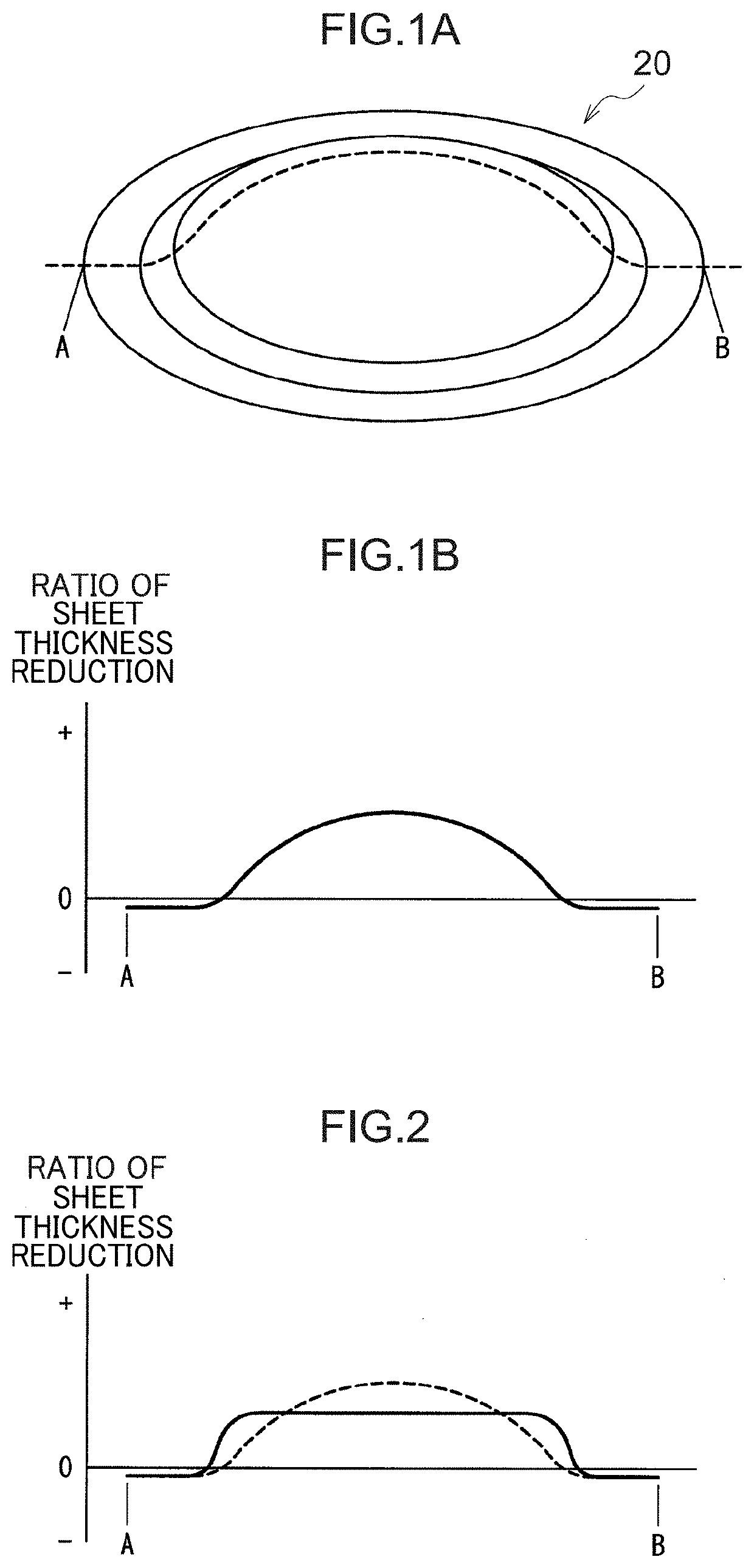Metal sheet forming method, intermediate shape design method, metal sheet forming die, computer program, and recording medium
- Summary
- Abstract
- Description
- Claims
- Application Information
AI Technical Summary
Benefits of technology
Problems solved by technology
Method used
Image
Examples
first exemplary embodiment
[0272]As illustrated by the flowchart in FIG. 6, a method of forming a metal sheet of a first exemplary embodiment is a method in which, when press-forming a metal sheet (90) to form a target shape, the metal sheet (90) is formed (91) into an intermediate shape that is different from the target shape, and a metal sheet formed into the intermediate shape (92) is then formed into the target shape to obtain a formed article (94). When this is performed, a shape obtained by following the procedure below is adopted as the intermediate shape. Namely, element data (D) for the hypothetical metal sheet 25 prior to forming is derived. A deformed shape is then adopted that has been deformed by imparting a strain to some elements in the element data (D) that is a strain required to deform each of these elements to the shape of each of the topologically corresponding elements in the element data (B) for the post-forming shaped metal sheet 26, while either imparting a strain to the remaining elem...
second exemplary embodiment
[0335]Explanation follows regarding a second exemplary embodiment.
[0336]Although in the first exemplary embodiment explanation has been given regarding an example in which a metal sheet blank is formed into the intermediate shape, and the intermediate shape is then formed into the target shape, the present invention is not limited to a single intermediate shape, and a blank may be formed into a target shape via plural intermediate shapes. In the second exemplary embodiment, explanation will be given regarding a case in which the metal sheet blank is formed into a first intermediate shape, the first intermediate shape is formed into a second intermediate shape, and the second intermediate shape is formed into the target shape. Note that in the present exemplary embodiment, the shape and element data of a provisional metal sheet and a post-forming shaped metal sheet that form the basis for designing the intermediate shapes are similar to those of the first exemplary embodiment.
[0337]E...
example 1
[0344]Based on the shapes of the product shape 30 illustrated in FIG. 10A and FIG. 10B and the provisional metal sheet 24 illustrated in FIG. 11A, the shape of the hypothetical metal sheet 25 prior to forming and an intermediate shape were derived by using the procedure explained in the first exemplary embodiment. Then after forming the four types of sheet steel having the shape of the hypothetical metal sheet 25 prior to forming and the sheet thicknesses, tensile strengths, and elongations (EL) listed in Table 1 into the intermediate shape, the target shape was then formed. FIG. 16B illustrates a target shape when formed from steel of a material 2 in the shape of the hypothetical metal sheet 25. The shape of the hypothetical metal sheet 25 prior to forming and the intermediate shape were derived according to the flowcharts of FIG. 7, FIG. 8, and FIG. 9. First, the element data (B) for the post-forming shaped metal sheet 26 illustrated in FIG. 12 was derived using forming analysis f...
PUM
| Property | Measurement | Unit |
|---|---|---|
| Fraction | aaaaa | aaaaa |
| Fraction | aaaaa | aaaaa |
| Fraction | aaaaa | aaaaa |
Abstract
Description
Claims
Application Information
 Login to View More
Login to View More - R&D
- Intellectual Property
- Life Sciences
- Materials
- Tech Scout
- Unparalleled Data Quality
- Higher Quality Content
- 60% Fewer Hallucinations
Browse by: Latest US Patents, China's latest patents, Technical Efficacy Thesaurus, Application Domain, Technology Topic, Popular Technical Reports.
© 2025 PatSnap. All rights reserved.Legal|Privacy policy|Modern Slavery Act Transparency Statement|Sitemap|About US| Contact US: help@patsnap.com



